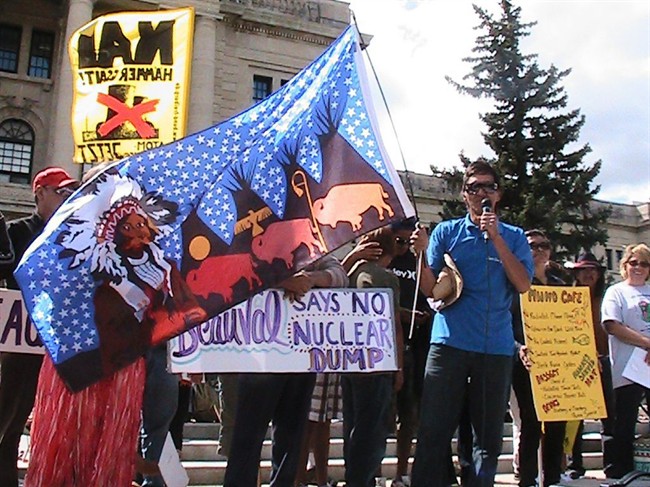REGINA – Some northern Saskatchewan residents say they’re drawing a line in the sand to protect the environment from nuclear waste.

The protesters left the community of Pinehouse on July 27, walking about 820 kilometres, and were joined by others on the way to Regina to ask the province to ban radioactive waste.
“It’s for fear of our future generations to not impose this decision on them that would kill our watertable, our watershed,” Max Morin, one of the walk organizers, said Tuesday at a rally in front of the legislature.
“The basin over there is just one big sponge that keeps our air clean, too. So it’s all about the love of our future generations.”
Pinehouse is one of three Saskatchewan communities being considered for an underground storage dump by the federal Nuclear Waste Management Organization (NWMO).
The organization is trying to find a site that would serve as a dump for all the country’s nuclear waste. The decision to build a centralized storage site was made by the federal government in 2007. Estimates put the price-tag from $16 billion to $24 billion over the life of the facility, which could last 100 years.
Officials will check the suitability of communities against criteria that could rule them out – including the presence of groundwater, fault lines or natural resources. Studies have cited the Canadian Shield as the ideal type of geological formation for housing a nuclear store.
The English River First Nation and the township of Creighton are also on the list. Federal officials have stressed that communities can drop out of the process whenever they like.
- ‘Shock and disbelief’ after Manitoba school trustee’s Indigenous comments
- Canadian man dies during Texas Ironman event. His widow wants answers as to why
- Several baby products have been recalled by Health Canada. Here’s the list
- ‘Sciatica was gone’: hospital performs robot-assisted spinal surgery in Canadian first
But Morin claimed Saskatchewan residents aren’t getting all the information they need to make an informed decision.
“The walk is about spreading the word, uniting Saskatchewan. NWMO has been so very deceiving and it has managed to divide Saskatchewan into two – north and south -_ and they’ve divided communities, too, and they’ve divided families,” said Morin.
Saskatchewan is the world’s largest producer of uranium, the key component in nuclear power generation, but mining the raw material is as far as the province has gone.
A government-appointed, 12-member panel, known as the Uranium Development Partnership, said in a 2009 report that storage of nuclear waste would be a good economic option for the province, but it must have community support.
The crowd gathered in front of the legislature Tuesday chanted, “No nuclear waste in Saskatchewan.”
The protesters, including Jim Harding, a retired professor of environmental and justice studies at the University of Regina, said Saskatchewan Premier Brad Wall should do what Quebec and Manitoba have done – speak out against the transportation and storage of nuclear waste.
“We’ve been mining uranium, which goes into creating the nuclear waste and now the whole thing is confronting us with Manitoba saying no to waste, Quebec saying no to waste, Ontario not having a place to deal with their own waste and then the attempt to bribe people in the north with this being an economic development option,” said Harding.
“We don’t want a toxic economy anywhere in Saskatchewan, north or south.”
Harding and other protesters said storing and transporting nuclear waste presents big environmental and health risks. They’re gathering signatures on a petition which they plan to present to the government a month before the provincial election in November.
“The implications would be that our government is basically dooming the north to nuclear waste reprocessing plants,” said Harding.
“It’d be the end of eco-tourism, the renewable economy will be jeopardized, so it has profound implications for the future of the country, for the future of our province.”



Comments